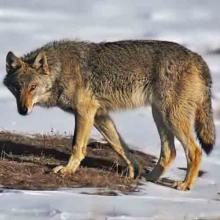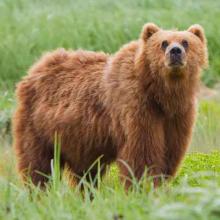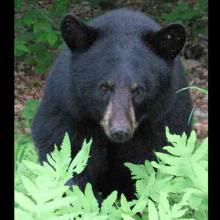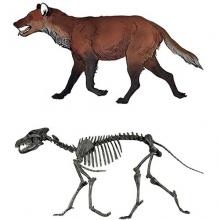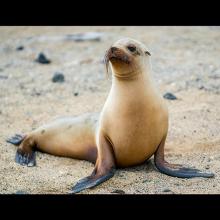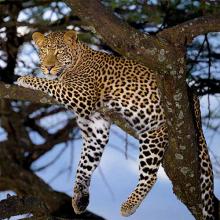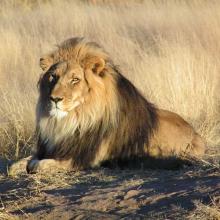Canis lupus
Common name:
Gray wolf
Suborder:
Caniformia
Order:
Carnivora
Class:
Mammalia
Ursus arctos
Common name:
Grizzly bear
Suborder:
Caniformia
Order:
Carnivora
Class:
Mammalia
Lynx lynx
Common name:
Eurasian lynx
Suborder:
Feliformia
Order:
Carnivora
Class:
Mammalia
Vulpes vulpes
Common name:
Red fox
Suborder:
Caniformia
Order:
Carnivora
Class:
Mammalia
Ursus americanus
Common name:
American black bear
Suborder:
Caniformia
Order:
Carnivora
Class:
Mammalia
Aenocyon dirus
Common name:
Dire wolf
Suborder:
-n/a-
Order:
Carnivora
Class:
Mammalia
Zalophus wollebaeki
Common name:
Galápagos sea lion
Suborder:
Caniformia
Order:
Carnivora
Class:
Mammalia
Panthera pardus
Common name:
Leopard
Suborder:
Feliformia
Order:
Carnivora
Class:
Mammalia
Panthera leo
Common name:
Lion
Suborder:
Feliformia
Order:
Carnivora
Class:
Mammalia
Canis lupus
Common name:
Gray wolf
Suborder:
Caniformia
Order:
Carnivora
Class:
Mammalia
Ursus arctos
Common name:
Grizzly bear
Suborder:
Caniformia
Order:
Carnivora
Class:
Mammalia
Lynx lynx
Common name:
Eurasian lynx
Suborder:
Feliformia
Order:
Carnivora
Class:
Mammalia
Vulpes vulpes
Common name:
Red fox
Suborder:
Caniformia
Order:
Carnivora
Class:
Mammalia
Ursus americanus
Common name:
American black bear
Suborder:
Caniformia
Order:
Carnivora
Class:
Mammalia
Aenocyon dirus
Common name:
Dire wolf
Suborder:
-n/a-
Order:
Carnivora
Class:
Mammalia
Zalophus wollebaeki
Common name:
Galápagos sea lion
Suborder:
Caniformia
Order:
Carnivora
Class:
Mammalia
Panthera pardus
Common name:
Leopard
Suborder:
Feliformia
Order:
Carnivora
Class:
Mammalia
Panthera leo
Common name:
Lion
Suborder:
Feliformia
Order:
Carnivora
Class:
Mammalia
Canis lupus
Common name:
Gray wolf
Suborder:
Caniformia
Order:
Carnivora
Class:
Mammalia
Ursus arctos
Common name:
Grizzly bear
Suborder:
Caniformia
Order:
Carnivora
Class:
Mammalia
Lynx lynx
Common name:
Eurasian lynx
Suborder:
Feliformia
Order:
Carnivora
Class:
Mammalia
Vulpes vulpes
Common name:
Red fox
Suborder:
Caniformia
Order:
Carnivora
Class:
Mammalia
Ursus americanus
Common name:
American black bear
Suborder:
Caniformia
Order:
Carnivora
Class:
Mammalia
Aenocyon dirus
Common name:
Dire wolf
Suborder:
-n/a-
Order:
Carnivora
Class:
Mammalia
Zalophus wollebaeki
Common name:
Galápagos sea lion
Suborder:
Caniformia
Order:
Carnivora
Class:
Mammalia
Panthera pardus
Common name:
Leopard
Suborder:
Feliformia
Order:
Carnivora
Class:
Mammalia
Panthera leo
Common name:
Lion
Suborder:
Feliformia
Order:
Carnivora
Class:
Mammalia
Order-Animalia: Carnivora
The Carnivora is the mammal order specialized in primarily eating flesh. though some species are omnivorous, like raccoons and bears, and quite a few species like pandas are specialized herbivores. The word 'carnivore' is derived from Latin carō (stem carn-) "flesh" and vorāre "to devour", it refers to any meat-eating organism. The order Carnivora is the fifth largest order of mammals and one of the more successful members of the group; it comprises at least 279 species living on every major landmass and in a variety of habitats, ranging the cold polar regions to the hyper-arid region of the Sahara Desert to the open seas. They come in a huge array of different body plans in contrasting shapes and sizes. The smallest carnivoran is the least weasel (Mustela nivalis) with a body length of about 11 cm (4.3 in) and a weight of about 25 g (0.88 oz). The largest is the southern elephant seal (Mirounga leonina), with adult males weighing up to 5,000 kg (11,000 lb) and measuring up to 6.7 m (22 ft). All species of carnivorans are descended from a group of mammals which were related to today's pangolins, having appeared in North America 6 million years after the Cretaceous–Paleogene extinction event. These early ancestors of carnivorans would have resembled small weasel or genet-like mammals, occupying a nocturnal shift on the forest floor or in the trees, as other groups of mammals like the mesonychians and creodonts were occupying the top faunivorous niche. However, by the time Miocene epoch appeared, most if not all of the major lineages and families of carnivorans had diversified and took over this niche.
Carnivora can be divided into two subclades: the cat-like Feliformia and the dog-like Caniformia which are differentiated based on the structure of their ear bones and cranial features. The feliforms include families such as the cats, the hyenas, the mongooses and the viverrids. The majority of feliform species are found in the Old World, though the cats and one extinct genus of hyena have successfully diversified into the Americas. The caniforms include the dogs, bears, raccoons, weasels, and pinnipeds. Members of this group are found worldwide and with incredible diversity in their diet, behavior, and morphology. Despite this the two groups of carnivorans share several unique traits, one being the presence of the carnassial teeth. In carnivorans the carnassial pair is made up by the fourth upper premolar and the first lower molar teeth. There is variation among the carnassial pair depending on the family. Some species are cursorial and the foot posture in terrestrial species is either digitigrade or plantigrade. In pinnipeds the feet have become flippers where the locomotion is unique in each of the pinniped families.
After primates, carnivorans are arguably the group of mammals of most interest to humans. The dog is noteworthy for not only being the first species of carnivoran to be domesticated, but also the first species of any organism. In the last 10 to 12,000 years humans have selectively bred dogs for a variety of different tasks and today there are well over 400 breeds. The cat is another domesticated carnivoran and it is today considered one of the most successful species on the planet, due to their close proximity to humans and the popularity of cats as pets. Many other species are popular, and they are often charismatic megafauna. Many civilizations have incorporated a species of carnivoran into their culture such as the lion, viewed as royalty. Yet many species such as wolves and the big cats have been broadly hunted, resulting in extirpation in some areas. Habitat loss and human encroachment as well as climate change have been the primary cause of many species going into decline. Four species of carnivorans have gone extinct since the 1600s: Falkland Island Wolf (Dusicyon australis) in 1876; the Sea Mink (Neovison macrodon) in 1894; the Japanese Sea Lion (Zalophus japonicus) in 1951 and the Caribbean Monk Seal (Neomonachus tropicalis) in 1952. Some species such as the red fox (Vulpes vulpes) and stoat (Mustela erminea) have been introduced to Australasia that have caused many native species to become endangered or even extinct.
Reference: Wikipedia

